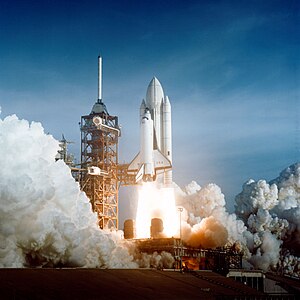
Back إس تي إس-1 Arabic STS-1 Bulgarian STS-1 Catalan STS-1 Czech STS-1 Danish STS-1 German STS-1 Spanish STS-1 Estonian استیاس-۱ Persian STS-1 Finnish
 The launch of STS-1, April 12, 1981 | |
| Names | Space Transportation System-1 |
|---|---|
| Mission type | Test flight |
| Operator | NASA |
| COSPAR ID | 1981-034A |
| SATCAT no. | 12399 |
| Mission duration | 2 days, 6 hours, 20 minutes, 53 seconds (achieved) |
| Distance travelled | 1,729,348 km (1,074,567 mi) |
| Orbits completed | 36 |
| Spacecraft properties | |
| Spacecraft | Space Shuttle Columbia |
| Crew | |
| Crew size | 2 |
| Members | |
| Start of mission | |
| Launch date | April 12, 1981, 12:00:04 UTC |
| Rocket | Space Shuttle Columbia |
| Launch site | Kennedy Space Center, LC-39A |
| Contractor | Rockwell International |
| End of mission | |
| Landing date | April 14, 1981, 18:20:57 UTC |
| Landing site | Edwards Air Force Base, Runway 23 |
| Orbital parameters | |
| Reference system | Geocentric orbit |
| Regime | Low Earth orbit |
| Perigee altitude | 246 km (153 mi) |
| Apogee altitude | 274 km (170 mi) |
| Inclination | 40.30° |
| Period | 89.88 minutes |
| Instruments | |
| Development Flight Instrumentation (DFI) | |
 STS-1 mission patch  Young and Crippen | |
STS-1 (Space Transportation System-1) was the first orbital spaceflight of NASA's Space Shuttle program. The first orbiter, Columbia, launched on April 12, 1981,[1] and returned on April 14, 1981, 54.5 hours later, having orbited the Earth 37 times. Columbia carried a crew of two—mission commander John W. Young and pilot Robert L. Crippen. It was the first American crewed space flight since the Apollo–Soyuz Test Project (ASTP) in 1975. STS-1 was also the maiden test flight of a new American spacecraft to carry a crew, though it was preceded by atmospheric testing (ALT) of the orbiter and ground testing of the Space Shuttle system.
The launch occurred on the 20th anniversary of Vostok 1, the first human spaceflight, performed by Yuri Gagarin for the USSR. This was a coincidence rather than a celebration of the anniversary; a technical problem had prevented STS-1 from launching two days earlier, as was planned.
© MMXXIII Rich X Search. We shall prevail. All rights reserved. Rich X Search